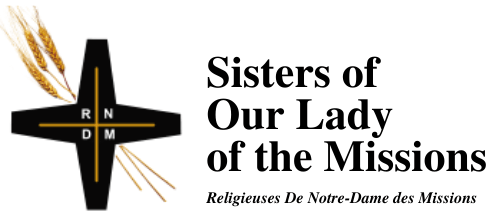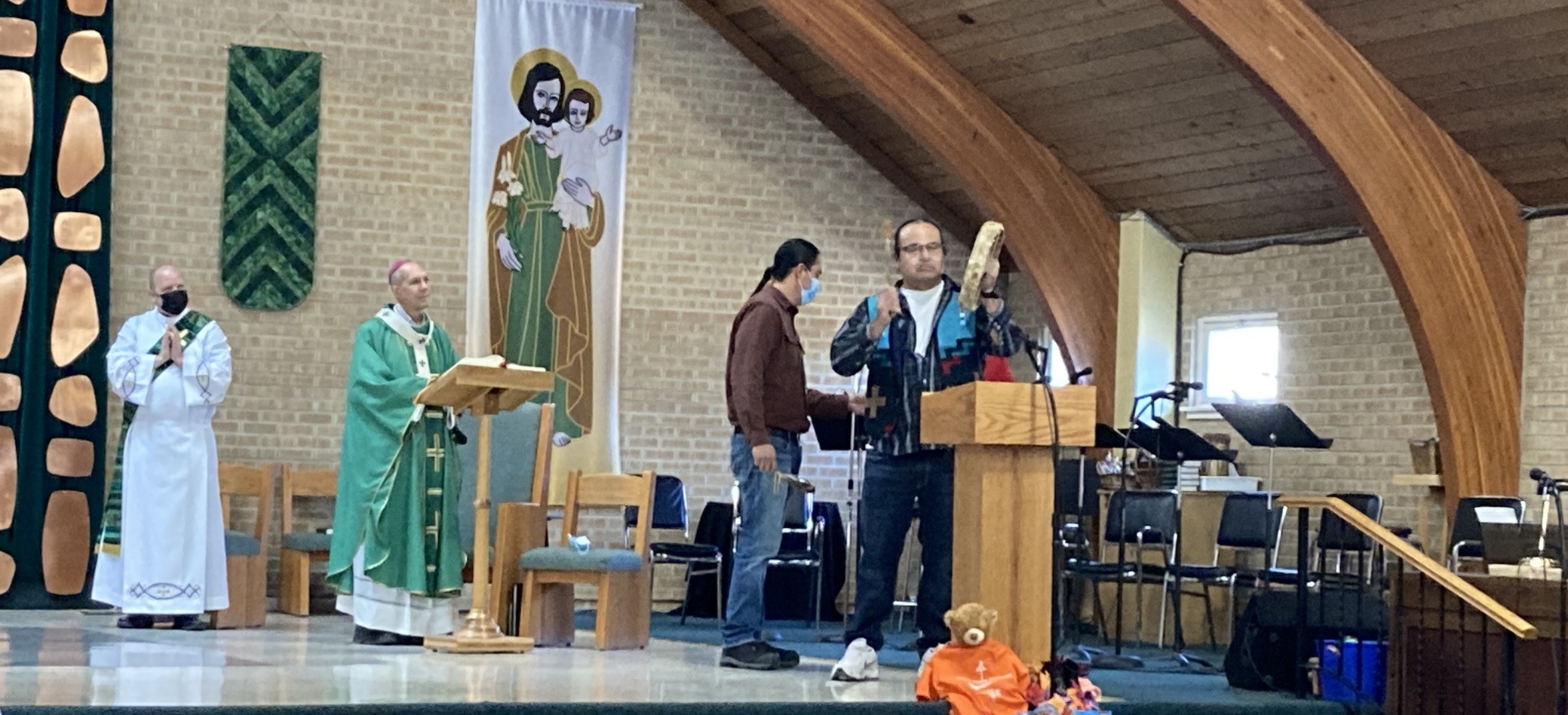

Journeys and Experiences
Celebrating Our New Mission in Canada
Volume 1, #2

Greetings to all,
In Canada we are beginning to acknowledge the land when we begin an event, either religious or Civil. It is made to honor the Treaties that were signed and as an expression that we desire to walk with our indigenous brothers and sisters on this journey of reconciliation. We are all Treaty People.
We are grateful to the Archdiocese of Regina who extended the invitation to participate in this course “Church and Reconciliation with indigenous Peoples: framing ecclesial and theological questions” offered by St. Paul University in Ottawa, in June of this year. We are grateful to Sr. ReAnne and Kelly Bourke, Chaplain at Campion College, who arranged for Thuong, Pricilla, Nwe Ni (Helen) and Jacinta to be visitors to the course, due to their International visa status. Petite and I audited the course.
The course although offered academically to students was more like sitting around with a circle of friends and sharing stories. It was on Zoom. There were 18 presenters over the 5 days and 5 hours per day. Each one began with a personal story of connection to the land they were living on. There were indigenous and non- indigenous presenters. After their sharing, most of the presenters stayed to listen to the other presenters during the week… This, along with the contemplative pace a set by the co facilitators Michel Andraos and Peter Bisson, gave a very relaxed feeling of being in community.
My reflection is on Bishop Don Bolen’s sharing:
Reflections on the Path of Truth and Reconciliation
Don began his reflection with his relationship to the land. He likes to go on 10-12 day prairie walks with friends during the summer. On one of these walks, he discovered, along with his companions that one of the earliest signs of indigenous life was found, in a location, about a half an hour from his hometown of Gravel Bourg, Saskatchewan. It was an eye opener for him. He, like most of us on the prairies, thought that our Canadian history began with our great grandparents settling on the prairies. It was an awakening for him to become aware that the indigenous were here long before that event.
So much so that when he moved to Saskatoon in 2010 as the Bishop. The Bishop’s residence did not bring him into day to day contact with the indigenous people in Saskatoon. He moved. When the” 94 Calls to Action” were published in 2015 by the Truth and Reconciliation Commission, Don realized that he had already been listening to the indigenous peoples stories of the residential schools. These schools had been funded by the government to “take the Indian out of the child.” The diverse Christian denominations, including the Catholic Church, had responded to that colonial call, in good faith. The schools existed from the turn of the century until 1996. As Don said through the “Calls to action” the voices of survivors “cried out to us and they cry out to us as a nation.”
Francis was elected as Pope in 2013. In 2016, Don was named Archbishop of Regina. “The Calls to Action were a road map for all” as Don put it. He brought the Calls to Action focus to the indigenous ministry that was already being carried on for many years in the Archdiocese. These calls were “reversing the logic of colonization, they would say that it is the indigenous peoples of this land who are calling us to engage with them and the land.” “It was a joy as we began the journey with the kokums (Cree word for Grandmothers and elders). “We began walking in a new way.” Don explained.
The old adage that became a rule of thumb for the Truth and Reconciliation Commission in the Archdiocese was “Nothing about us, without us,” This maxim was implemented into four fields of activity in the archdiocese. They were, education, Parishes, formation of seminarians, priests and lay people and justice for the indigenous peoples. “The last one is calling us to learn a new model of solidarity,” Don reflected.
One project which is close to the heart of the Truth and Reconciliation Commission in the Archdiocese is the “Project Indigenous Spirituality”. Susan and Don are a part of that Commission. Ultimately, they will present the paper to the CCCB (Canadian Conference of Catholic Bishops). Don spoke of the “beautiful traditions that were suppressed “as Colonization took hold to form what we now know as Canada.’ He felt that we lost a rich encounter that needs to be heard now. His extensive work with ecumenism has taught him ways of dialogue that will help us to engage and discover what we share in common.
Susan Beaudin, shared her presentation following Don’s talk. She spoke of her own personal story. She found that working on the Indigenous Spirituality Project, opened her” heart to start walking with the Church again.”
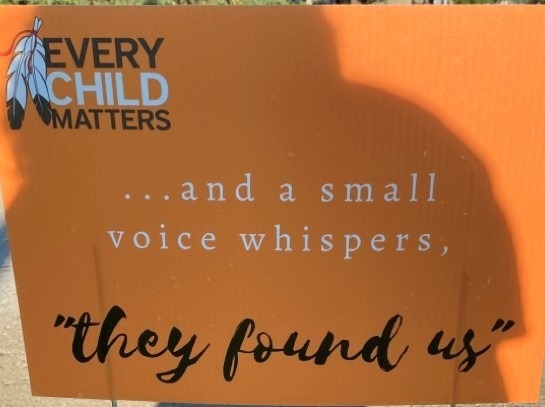
…..AND A SMALL VOICE WHISPERS …
“They have finally found us.”
As an endnote to this summary of Don’s talk. The Chief Cadmus Delorme of the Cowessess Reserve in the Archdiocese, in late June, gave a news release that another cemetery of 751 unmarked graves had been identified. It sent another wave of shock and grief across the country as well as opened dialogue on all levels. It also changed the way we celebrated Canada Day, flag flew at half- mast and the indigenous culture, ceremonies and vigils had a central place in most events.
The members of the CCCB were unable to give a unified voice to the requested CALL to ACTION #58, requesting the Pope to apologize to the survivors of residential schools on Canadian soil. A commission has been preparing for over two years. It is formed of indigenous chiefs and survivors and Bishops. They will go to Rome in the fall to invite the Pope to respond to this request by the Residential school survivors. There are signs of hope.
Also, the question of why the Catholic Church could only raise $4million of the promised $25 million? Don and the other 4 Bishops of Saskatchewan reopened the fundraising after talking with the indigenous people. The Archdiocese of Toronto and Diocese of Calgary have said they would join the Saskatchewan Bishops. The other Christian Church denominations involved have responded many years ago. Don had said that the Calls to Action are an invitation to engage with the indigenous people not a checklist. The journey continues for all of us.
Patricia Orban RNDM
Dialogue at the Heart of Mission
I have been reflecting on the idea of dialogue in the context of indigenous relations. As I engage in indigenous contexts, my ideas about dialogue are expanding and changing. I wish to share some of the ideas that I am reflecting on.
I think ongoing dialogue with indigenous peoples may happen in the Church in two ways:
a) Intrareligious dialogue. This happens with the members of the Church who are indigenous themselves. Indigenous spirituality and practices are not readily accepted as part of Catholic public liturgies, for example. Sr. Eva Solomon, CSJ wrote about interculturation and this cannot happen unless the Church is open to dialogue with indigenous members. Here, indigenous members discern their path both as Indigenous and Catholics. Some may regard this as syncretism. It may be possible that the Indigenous members of the Church experience being not accepted by the Church and Indigenous communities. I experienced examples of interculturation in Native Peoples Mission (Toronto), Kateri Native Ministry (Ottawa) and in St. Kateri Parish (Winnipeg). I have the privilege of serving with John Robinson, an indigenous elder in the Native Peoples Mission.
b) Interreligious dialogue. This happens with members of Indigenous communities who are practicing Indigenous ways. The Church engages with them NOT for the intention of evangelizing them but to sincerely learn. We may participate in ceremonies as guests whenever we are invited. Here, non-indigenous church members engage in dialogue in the same way as we do with Muslims, Buddhists, and Hindus etc. We strip ourselves of the agenda to try to convert them to being Christians. It may also be possible that we as Church members facilitate Indigenous resurgence like what happened to Eddy Robinson in Native Peoples’ Parish in Toronto, an exceptional case of “conversion” into his deep roots as an indigenous person. He found his self-identity through his parish priest. The parish priest invited him during his confirmation to go on a vision quest and to choose his saint. Eddy chose Crazy Horse, an indigenous leader who defended his community. The priest supported him. Eddy left the Church and is discovering the depth of his indigenous spirituality.
Please note that John Robinson (above) is the uncle of Eddy Robinson (below). Both have chosen different paths as Indigenous. The Church must be open to both directions. It may be our preference to not lose Indigenous members but the church must be a space of dialogue, wherever it leads. What kind of ecclesiology or theology for that matter supports this?
Another idea that I wish to share is the profound effects of colonization in the fragmentation of communities, “Divide and Conquer.” In the Filipino experience, the term, “Indigenous peoples” may be a social construct. It is a self-ascription of a community, according to the Indigenous Peoples’ Rights Act (Philippine Law). I am not saying it to diminish the term but to have a better understanding of it in relation to the Filipino experience. Inhabitants of the Islands could claim indigeneity because American/European colonizers did not really stay in the Islands and settled. There are very few of them. So, the people, now called, Filipinos, are technically indigenous to the Islands. But why do we have Indigenous peoples as a legal term? This is due to the effects of colonization. Those who have been Christianized (by association Westernized) became the mainstream, and the marginalized, were those who were not, those who were pushed to the margins due to their resistance to embrace Christianity or other cultures and maintained to practice their own spiritualties and cultures. The inhabitants of the Islands before the Spaniards came were practicing their own spirituality and cultures. By virtue of its Island culture, the inhabitants are naturally diverse. It is still discernible in our many languages. I shared the Filipino context to be aware of the profound effects of colonization in communities and societies. So, among ourselves, as Filipinos who have experienced colonization, we need to have on-going dialogue, too, to experience oneness.
I strongly feel that dialogue that leads to reconciliation and healing is at the heart of mission at this time. I continue to be deeply touched by the RNDM Canadian Province’s new mission initiative that engages the current context of Canada.
Petite Lao RNDM
Healing - Reconciliation
I attended a Zoom course about Indigenous relations from St Paul’s College. This course gave me more knowledge about the lives of indigenous people in Canada. I learned that they have great respect and treasure their language, culture, environment, and the elderly. The descendants of original Indigenous people pass on this culture and traditions to the present generation. Since I am now in Canada, I wish to learn about the indigenous culture here.
Each day at the beginning of the session they did the Four Direction Smudging and prayed for the people living around the globe. This ceremony was very meaningful to me and reminded me of the Buddhist culture in Myanmar; they also have a similar method of praying using music as they face the four directions.
I noted some differences between Canada and my country, Myanmar. France first colonized Canada and they took away the land from the indigenous peoples living here. The French colonizers asked missionaries to open religious schools to provide education. The parents were not asked about this plan, so the children were sent to these schools without their parents’ consent. This plan caused much conflict between the indigenous peoples and the Government and religious missionaries. The children faced many problems in the schools – different types of abuse and lack of adequate health care. Sometimes the children would try to run away, and some of them died on the way. Those who survived suffered trauma from these experiences and they hated the Missionaries.
The situation was similar in Myanmar. Britain colorized the country and they too asked Missionaries to open schools. At first the Missionaries helped the people with ploughing the fields and harvesting the crops; they also taught the faith, and many people were baptized Christian. Later they opened schools and hospital. Many people sent their children to the Missionary schools, but some of the children did not get a chance to go those schools. The Missionary Schools provided a good education, and later the people were sad to see the missionaries leave the country.
During the course, Sisters ReAnne and Doreen Topp gave some very helpful presentations. The two sisters have a very good relationship with each other. They shared that at the beginning of their relationship, they found it difficult to believe each other, especially for Doreen. Later on, they learned to believe and this was a freeing experience for them. They learned to share their pain, to listen and to cry together. Their listening and believing gave them strength, understanding, healing, and reconciliation. This was a long process for them. That was a very powerful experience and I realized that each of us can try that healing and reconciliation in our daily life.
Sr Eva shared about reconciliation. She said that reconciliation is not finished; we need to reconcile every day of our lives. Whatever happens, we need to share our pain and brokenness again and again in order to heal our painful life experiences. The first time I shared my pain, I cried a lot; the next time slowly I cried less and less. I experienced healing by sharing. Sister Eva said that reconciliation and healing are what we need to carry on until we die. I agree because in our lives we experience different kinds of mistake towards others and to ourselves. Also we need to choose our faith teachings so that we can reconcile with others.
We religious Missionaries need to listen to other people sharing their feelings so we can support their healing process journey.
Nwe Ni Oo (Helen) RNDM
Blessings in Every Direction
After the online course, I had a lot of things to think about and I would like to share some of my thoughts.
Frist of all, I would like to share about Sister Eva’s story. I admire her spirit and I am strengthened by her story. She said, “The whole reconciliation project or personal healing patterns on something that’s very spiritual and doesn’t end until death. Don’t expect to be able to say after 4 years ‘I am reconciled with you’. Maybe you are reconciled with some parts but not necessarily reconciled with all of life.” She invited me to listen to her story with my whole heart; a traditional way of learning recognizes that when I need something, it will come to me, and my mind will tell me. Her indigenous spirit is the Eagle Woman and her clan is the Deer and Bear. I think that’s why she is a strong woman with a gentle heart. She made a strong statement, “We will never know who we are as Canadians until we know who we are in relationship to the Indigenous peoples”.
She is a person of prayer, and believes what she prays. One day on her way home, she needed to pass through a field which did not belong to her family. In that field they raised horses so she needed to go slowly and calmly because she thought if she ran, she would scare the horses and they would chase after her. As she walked, she prayed “Jesus saves us, Jesus saves me”. At that time she was three years old and for the first time in her life she prayed to Jesus to save her. Another time she prayed the Rosary Novena to save her uncle who had only one lung and now had pneumonia. And God answered her prayers.
Another day she went with her family and relatives to a place to have a ceremony. Her relatives danced and she wanted to join with them but a leader refused to allow her because it was for Indians not for Catholics. She wondered why it was okay for her relatives who are also Catholic. That was the beginning of her questioning, ‘why is it okay to participate in an Indian ceremony in some circumstances and in the Catholic ceremony at other times’? Some examples would be a woman washing the body of a dead person to prepare them for burial, picking cedar to replace palm branches, etc.… Why was that?
One day she came home from school in tears and asked her mom why her classmate called her a dirty Indian. It was a painful experience and she never forgot it, not because of her friend but because of what her mother said. “They do that because ‘exnuaren’”, which means ‘they never learned anything different’. Those words comforted her many times. It healed and restored her beauty and dignity without putting down the others. Her mother helped her to reconcile by those words, so next day she continued to go to school with her head held high and let it go because they never learned anything different.
Her desire was to be a sister; she was trying to decide which congregation she would like to join. One day her uncle Ernest was beaten up by his friends after a dance. Sister Eva’s mother found him the next day and brought him to a hospital which belonged to the Sisters of St. Joseph. The sisters were very nice to him and his family. She started to ask the question, “Why do we as Native people do this to each other? We drink, fight, hurt and kill each other and ourselves. Why?” Alcohol is not the problem; it is a symptom of our problem. The real problem is that we Indigenous people do not know who we are. She realized her call to work with her own people. She decided to join the Sister of St. Joseph, so she could work with Indigenous people. The problem was that her sister wanted to join with her too. They needed a letter from a pastor as well as a vocation director. Luckily their pastor was the vocation director as well. He gave the letter to her sister but not to her. She was so shocked and upset but later on she thought it was good for her to stay at home to help her mother. That was a difficult time for her mother because she had a lot of work to do and needed extra hands. She never gave up her desire so the next year, she was able to enter the convent and work with her own people.
When I heard her story, I thought about myself in many situations and events. This is a blessing for me, a new direction to discover God’s will. Reflecting on what she shared, I reflect on my own experiences, both good and bad. I hope to have new eyes to see the beauty in nature and people. I strongly believe God is always with me to guide and help me to go through difficult times.
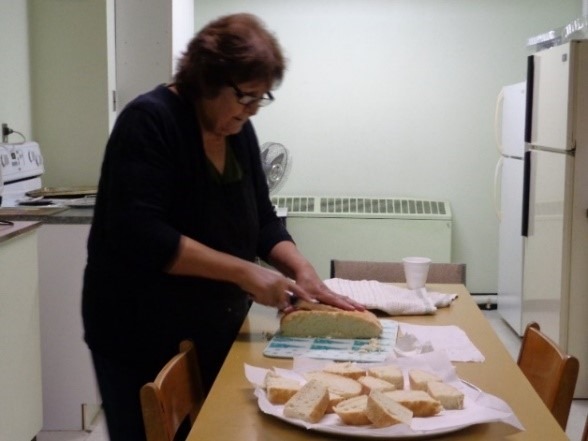
Secondly, I was touched by the relationship between Sister ReAnne and Doreen. They are very close to each other. Sister ReAnne said that if we/ I want to know their culture, we/I need to go beyond our comfort zone to spend time with them. It reminded me of St. Kateri Church where I work. I know their traditional food is bannock and I wanted to learn how to make it. A lady who is very good at baking bannock taught me. It seemed to be a community working together. Why do I say that? Because I needed to put water into flour with some ingredients to make a good dough; then I needed to knead it again and again.
Another time a leader of a drum group invited parishioners to join it. On the day they practiced drumming, I went and they looked at me wide-eyed and were surprised. I was shocked because of their reaction but I was brave and said “Could I join with you?” “Why not?” they said. Their culture and traditions are very rich; I learned so many things from them. At the end they gave me a small ball of sage to take home, which means they accepted me as a member.
Finally I thank God for giving me the opportunity to attend this course. It was a very heavy week but it helped me to see with new eyes and listen with my whole heart to explore their culture, their wisdom and their traditions.
Thuong Truong RNDM
Listening - The Missing Piece of Reconciliation
Hello everyone, it’s my pleasure to share with you some of the topics during one week of our course which different speakers brought into the light for our reflections about the indigenous relationships. It was a very vast topic to cover and to reflect upon. Most of the topics were surprising as well as enriching. The speakers have been actively working among the first nations and have made good studies with regard to Indigenous relationships.

Proverb 2:2 “Making your ear attentive to wisdom and inclining your heart to understanding”.
Bishop Sylvin worked as a young priest with Indigenous people for many years. Having lived with the people brought him great understanding and love towards them. This was eye opening for him. His first mission, Beauval was an Indian residential school which was established in 1929. He worked as a Chaplin at the school. It was an unusual experience. What he found was a dysfunctional system. At that time there were twelve kids up to 18 years old and cared for by childcare workers who began herding them like sheep right after breakfast. So father rearranged the children’s time table for masses morning to evenings. It didn’t matter if children came or not.
He also attended many conferences with regard to the indigenous relationship and there he learned original woundedness that followed from the colonization. Especially prevalent were alcohol, drug addiction, and sense of inferiority, suicide and family breakdown. He realized that loss of traditional livelihood, hunting, fishing and trapping were devastating for the men. It was a loss of dignity when you lose everything.
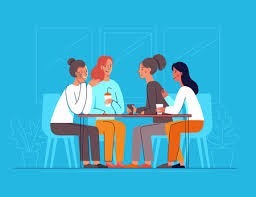
Seeing all this as a young priest, he thought of doing something and so he initiated a leadership course which imparted self-confidence, self-esteem, dignity to the participants and many other things. Indigenous people took this course very seriously and made it their own. Indigenous team members helped it to run for 40 years.
Later Oblates took significant steps to arrange an Oblate summer Amerindian leadership a session in 1978 which brought oblate missionaries, Church leaders and Indigenous leaders for two week sessions which focused on scriptures, theology and missiology. In that he was impressed by a young lady by her work as a youth leader. She had done marvelous work among the youth. When she was asked her secret of success, she said one word “LISTENING”. What she did was create a safe space for the young people to share their concerns, thoughts, and their problems. They did it naturally and blossomed and developed humanly, spiritually, and began to live better lives.
Working among the youth also brought more life and energy. They would laugh, sing Cree songs etc. He felt colonization caused much spiritual harm. This made him realize that ministry of presence and listening were important. After seven years of ministry he got to learn a native language. He began participating in ceremonies like round dances, Powows, pipe ceremonies and sweat lodges and tried to understand the culture from within while he lived with families.
When he was Mudie Lake, he went door to door practicing the Cree language, introducing himself, getting to know people and they got to know him. This kind of ministry led them to healing and reconciliation in its own way. They also started a task force and began an 8 day orientation of living outside, attending sweat lodges and meeting with the elders. That was an awareness experience of men and women of all ages. He shared his experience, were people told them not to abandon them. They asked them to stay, saying “don’t walk ahead of us, don’t walk behind us but walk with us”. That was a clear invitation that in spite of all the challenges and difficulties they were ready to accept them.
TRC conference he was able to attend a few sessions. What struck him was children who lived in small communities would disappear in the fall. There were no children playing, laughing, no grandparents parenting. The children at the school were not parented. Later when they became parents themselves they did not know how to parent. It was a multi-generational impact of the residential school system.
In 1991 the Oblates issued an apology. It was a good apology but it was incomplete. A reaction came from an Indigenous person. She heard the apology and told father that she had walked out of the Church for ten years because no one took time to hear her stories.
Some of the art of apologies he shared were –
Requesting permission to share something very personal with the person or persons who have been hurt by our action.
Reminding them of the nature of our actions, with a humble and honest admission of guilt and expressing a willingness to take responsibility for those actions.
Inviting the person who has been hurt by our actions to share their feelings about our hurtful behavior.
Listening from the heart, without defensiveness, rationalization or justification, to the pain that is being shared and soaking up that pain.
A humble request for forgiveness, without putting any expectation on the person or persons. It could be worded “can you find it in your heart to forgive me?’’
Making a declaration to change, to try never to do those hurtful actions again. An apology without a declaration to change is almost meaningless.
Finally, asking sincerely how we can make amends, what we can do to make things right, and to bring about greater justice.
Bishop tells that in the past we did not listen or hear the people’s stories. When people start listening to their stories healing can happen. To see that healing that was happening, hearing their elders, grandfathers, mothers talk about their tears and what they were experiencing and understanding why they acted out in a different way, those were healing experiences.
Colonization “The policy or practice of acquiring full or practice political control over another country occupying with settlers and exploiting it economically” Steve Andreas.
We all need to be involved in decolonization healing and reconciliation. Colonization is still going on.
Observation

Kamloops is a wakeup call
Invitation to redemptive suffering and purification
Societal shift and change
Recovery of dignity and a leading role
Let’s hope for change and hold in our hearts all those who suffer injustice towards life. May our creator heal the broken hearted and sustain everyone in a life that is true and just.
Pricilla Lugun RNDM
Church and Reconciliation with Indigenous Peoples
Here I would like to share with you my learning from the course attended together with my RNDMs companions on the topic ‘Church and Reconciliation with Indigenous Peoples’. Listening to the different presenters and their insights, I learned about Muskeg Lake Cree Nation – On Being Prepared to be engaged in Life after Colonialism and Baptism by Harry Lafond, he starts by asking questions… Where have we been? Where do we want to be? …
“There is so much to lament, so many hauntings, restorative solidarity to realize. But as we danced round and round that circle of Landlines, Bloodlines, Song lines, I felt the power of radical love, the warmth of a wind rising against the storm of settler colonialism, let us dance together into a decolonized future, that by turning, turning we come round right.” (Elaine Enns)
Every community has their own story to tell, share and learn. Diversity is a way of life rich in language and unique in culture, faith and tradition. Harry Lafond’s story is about one small community in North America who strives to reach out to others and to form the future generation to bring richness to the place. The coming of the Church has taught them new ideas and ways of thinking as regard to Baptism. They ask if Baptism has a future for them. They live in unity within their community. They have a chief as a leader or representative in any occasions, functions, programs of the community to which they belong. They have a sense of oneness – they give hospitality and welcome to other communities to live and share their culture – e.g. dance, drumming and food as well.
Further he explained how a Cree spirituality of the land includes all flora and fauna. All are connected, everything holds together as relatives, and is a central value of every person – to share resources and life. ‘Ki-Iaskimaw’ (Cree language) means: Our Land and Life – it speaks about the beauty of nature and the richness of its resources. It also refers to the Women who are the persons who preserve and carry water in their body. They passed on knowledge to new generations by teaching children, grandchildren and great grandchildren the gift of nature, land, herbs, medicines and flowers etc. The great teaching – ‘Wahkohtawin’ in Cree, is a teaching that holds all in one regarding political and spiritual. Lafond said ‘I need to know where I came from, I need to learn from wahkohtawin to help me/us realize the important teaching of the elders’… as some still denied their family from where they come from, and where their connection is with others.
Celebrate grandmother- she is a leader in a Cree way. She taught them to raise children because they are a precious gift to the family. Lessons from grandparents are great and valuable to inherit their heritage and language to each generation. As the elders were the mentors and teachers. Especially the grandmothers were the mentors of the family and the community as well. They celebrate leadership together after church services, prayers, ceremonies to honor the role they play – Leadership in education, community, family, society and church.
Niwi-wicisonan – Road to Freedom – from the political leaders, policy, Indian act. For 30 years they were like slaves. Later they learned to support and help one another for healing in their community. They realized their way of life and thinking was better. They are not shy to welcome other people to their community they offer tobacco as a sign of caring and relating in a good manner. They treat them well as one of their members and make them to feel at home. They did this up to capacity to build heart, mind and soul and to remember the teachings from the elders. The Cree people come together to talk about life in the community. As a group they taught about thankfulness and the richness of the diverse cultures. They demonstrate their ideas and place them in the wall or window for people to see their culture and language.
Miskasowin –finding one’s sense of origin: To keep the cultures alive they publish books with lots of information about their origin, where they come from. To know the Family history, the roots of the clans as spirituality is a wellness for people, celebration is part of the culture for anniversaries, and Cree democracy is different from Canadian democracy in many forms. Book publishing is a way of reaching out to people who wish to learn and search for their origins.
Miyo-wicehtowin- Expanding the circle – living together in a good spirit. By doing so they made rooms for other people. They did this in different ways for e.g. the young athletes to honor and encourage them to play sports not only in the reserve, but to reach out to others as well. Go out and reach out to find the challenges there – the way to encourage young people to choose sports. Family get-togethers are important to know and learn from one another by sharing jokes, stories and laughing together. They reach out to others by inviting people to join their circle. They celebrate survival – they pray and have a special chant ceremony with women, and they present her with a blanket as a sign of gratitude to Creator for giving her more years of life to share with us and continue to be a mother as a kokum.
After listening to the explanation I felt this topic is very much connected to our RNDMs ways of life. We come from a diversity of faith cultures and traditions to follow the same roots, to reach the goals of life where we treasure the spirituality and charism of our Foundress. We are proud to say that we too have a story to tell, to share and learn from our fore mothers or the first pioneers who stepped into the land that saw the seeds of faith. These courage women left us a huge legacy to impart education in all round development specially the young girls and women. The stories of their faith journeys in the vineyard of the Lord come alive when we turn to the pages of the History of the Congregation and the writing of Mother Foundress. The smallest seeds of faith which had begun in the Barbier family in France way back on the 18th century, have sprouted and grown in many places.
In Canada, four of our sister from France arrived at Grand Clairiere on 11th August 1898 for the first mission in Canada: M. St. Valerie (Marie Annoite), Sr. M. L’Eucharistie (Marie Palatin), M. St. Paul (Pauline Dutronquoy), and M. Madeleine de la Croix (Virginie Chapuis). Their encounter with Christ in work places means a lot to the following generations.
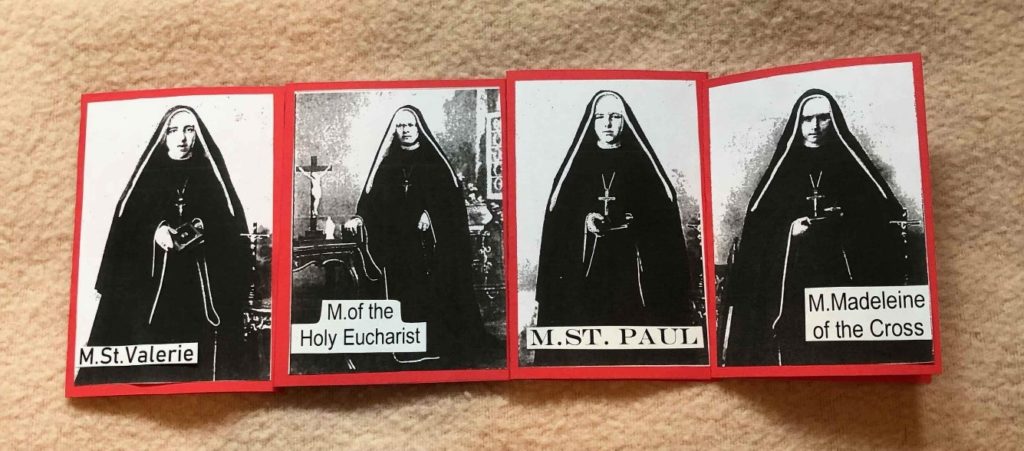
Their zealous missionary spirit had a great impact in the life of the Province, Congregation and the church. In the beginning everything was new to them: the climate, the culture, yet their determination to plant the seeds of faith in the fields of education and other ministries in the society were determined.
And so here we the present generations are fortunate to be in the same order to listen to the voice of the Spirit, learn from our elder Sisters and live the charism and spirituality of the Foundress in the midst of diverse cultures. In Manitoba as a community both in big and small groups we come regularly to share stories, prayers, meals, information. It is a lifelong learning to learn from our elders’ sisters listening to their stories and experiences both locally and globally in the mission fields. I have felt like I’m sitting in a classroom to draw inspiration from them but at present due to the restriction of pandemic we were not able to come together as before. This getting together regularly was such an opportunity to live the charism and spirit of our Foundress, to pass on to the generations. As a whole all are connected.
I conclude by quoting from the 2008 Chapter Document “We are one we are love” which spoke about this Sense of oneness, and that our longing to be One and to be Love inspires us to be an RNDM earth community. Our shared life in community:
“finds its source in God-Trinity, who has inscribed the rhythm of Divine relationships into the fabric of creation. We are drawn into this dance of communion with each other, interwoven and interdependent with all that is. We celebrate the grace of difference and the giftedness of each member as “friends in search of God’”
Praise the Lord!
Jacinta Dkhar RNDM
Sisters of Our Lady of the Missions
393 Gaboury Place
Winnipeg, MB
Canada
R2H 0L5
Phone: (204) 786-6051
Fax: (204) 691-0640
